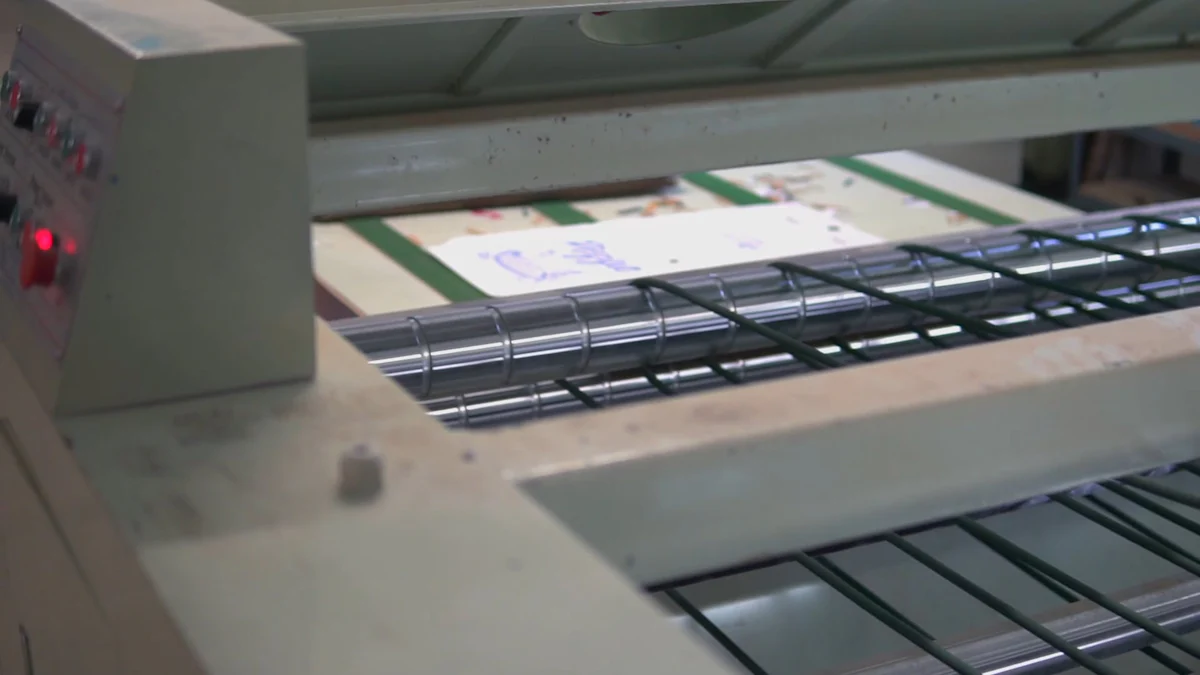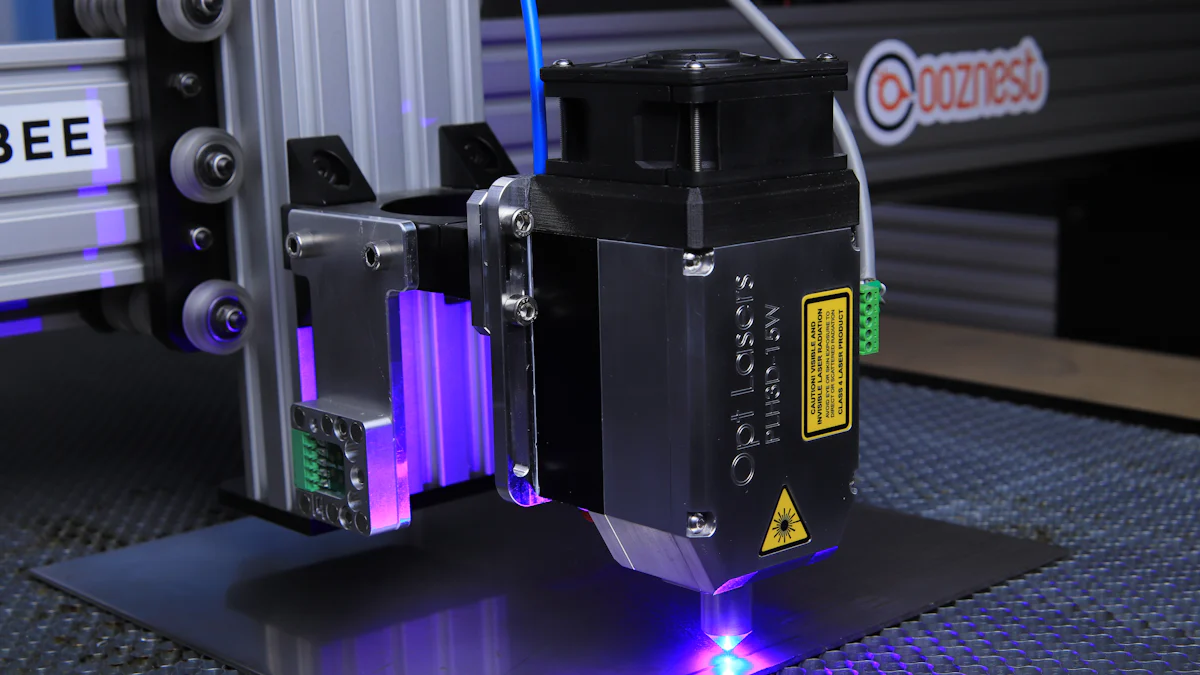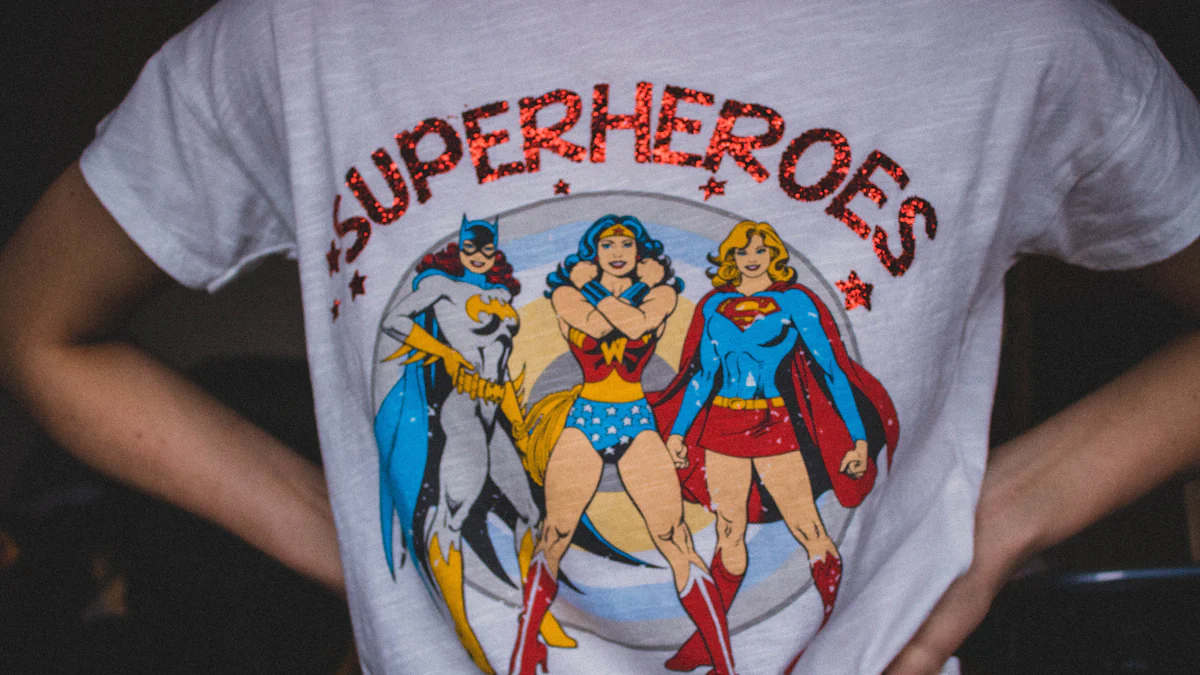
Choosing the right DTF printer for your T-shirt business can significantly impact your success. You need a printer that meets specific requirements to produce high-quality prints. Essential features include:
Resolution: High resolution ensures detailed and vibrant designs.
Ink System: Reliable ink systems, especially those with white ink circulation, are crucial for printing on dark fabrics.
Media Compatibility: Ensure the printer supports various transfer films for versatility.
These factors help you select a printer that balances performance and cost, enhancing your business’s productivity and quality.
Key Takeaways
Select a DTF printer with a resolution of at least 1440 dpi for sharp and vibrant designs.
Choose a printer with a reliable ink system, especially one that supports white ink for printing on dark fabrics.
Ensure media compatibility by selecting a printer that can handle various transfer films and fabric types.
Consider the balance between cost and quality; invest in a printer that meets your needs without overspending.
Prioritize brands with a strong reputation and good customer support to ensure reliability and assistance when needed.
Implement regular maintenance practices to extend the life of your printer and maintain print quality.
Stay updated on technological advancements and eco-friendly practices to enhance your business’s competitiveness and sustainability.
Essential Features of a DTF Printer

Resolution
High resolution is crucial for creating detailed designs. When you print intricate patterns on T-shirts, every line and color must appear sharp and vibrant. A DTF printer with a high resolution ensures that your designs maintain their integrity and appeal. For optimal results, look for printers with a resolution of at least 1440 dpi. This specification allows you to produce prints that capture fine details and vivid colors, enhancing the overall quality of your products.
Ink System
The ink system in a DTF printer plays a vital role in the printing process. DTF printers use special water-based pigment inks, including white ink and CMYK inks. The white ink acts as an underbase for dark fabrics, ensuring that colors remain bright and visible. It’s important to choose a printer with a reliable ink circulation system, especially for white ink, to prevent clogging and maintain consistent print quality. Regular maintenance of the ink system is essential to ensure longevity and efficiency. By keeping the ink system in good condition, you can avoid unnecessary downtime and costly repairs.
Media Compatibility
Media compatibility determines the versatility of your DTF printer. You need a printer that can handle various types of media, such as PET transfer films, to accommodate different printing needs. Consider the types of fabrics you plan to print on, like cotton, polyester, or nylon, and ensure your printer supports these materials. Proper media handling is also crucial. Look for features like roll feeders and automatic media alignment to streamline the printing process and reduce errors. By choosing a printer with broad media compatibility, you can expand your product offerings and meet diverse customer demands.
Key Equipment and Supplies
Printer
When choosing a DTF printer for your T-shirt business, you have two main types to consider: manual and automatic. Manual DTF printers are often more affordable and user-friendly, making them a popular choice for beginners. They require more hands-on management, which can be beneficial for those who prefer a more controlled printing process. On the other hand, automatic DTF printers offer quicker printing speeds and generally yield higher quality prints. These printers come equipped with features like automatic powder shakers and heat curing systems, which can significantly enhance efficiency.
Factors to Consider When Choosing a Printer
When selecting a DTF printer, focus on several key factors:
Resolution: Ensure the printer offers high resolution for sharp and vibrant designs.
Ink System: Look for reliable ink systems that support both light and dark fabric printing.
Print Speed: Consider the speed of the printer to meet your business’s productivity needs.
Unique Features: Automatic features can reduce manual labor and improve print consistency.
RIP Software
RIP (Raster Image Processor) software plays a crucial role in DTF printing. It converts digital images into a format that the printer can understand, ensuring accurate color reproduction and print quality.
Features to Look for in RIP Software
When choosing RIP software, consider the following features:
Color Management: Effective color management ensures that your prints match the original design.
User Interface: A user-friendly interface makes it easier to navigate and adjust settings.
Compatibility: Ensure the software is compatible with your DTF printer model.
Support and Updates: Regular updates and customer support can help you troubleshoot issues and improve performance.
Heat Press Machine
A heat press machine is essential in the DTF printing process. It transfers the design from the transfer film onto the fabric, ensuring a durable and vibrant print.
Specifications for an Effective Heat Press
When selecting a heat press machine, consider these specifications:
Temperature Control: Accurate temperature control is vital for consistent results.
Pressure Adjustment: Adjustable pressure settings allow you to accommodate different fabric types.
Size: Choose a size that matches the typical dimensions of your prints.
Durability: A sturdy build ensures longevity and reliability.
Curing Options
Methods for Curing DTF Prints
Curing is a crucial step in the DTF printing process. It ensures that the ink adheres properly to the fabric, resulting in durable and vibrant prints. You have several methods to choose from when curing DTF prints:
Heat Press: This is the most common method. You use a heat press machine to apply heat and pressure to the transfer film, bonding the ink to the fabric. This method is reliable and provides consistent results.
Conveyor Dryer: For larger production volumes, a conveyor dryer can be more efficient. It uses a continuous belt to move the printed fabric through a heated chamber, curing the ink as it passes through. This method is ideal for businesses with high output demands.
Infrared Heaters: These heaters use infrared radiation to cure the ink. They are energy-efficient and provide even heat distribution, which can be beneficial for achieving uniform curing across the fabric.
Hot Air Gun: A hot air gun is a more manual method, suitable for small-scale operations or touch-ups. It allows you to direct heat precisely where needed, but it requires careful handling to avoid uneven curing.
Pros and Cons of Different Curing Techniques
Each curing method has its advantages and disadvantages. Understanding these can help you choose the best option for your business needs.
Heat Press:
Pros: Provides consistent pressure and temperature, ensuring high-quality prints. It’s easy to use and widely available.
Cons: Limited to smaller batches due to the size of the press. It may not be suitable for very high-volume production.
Conveyor Dryer:
Pros: Ideal for large-scale production. It offers continuous operation, which increases efficiency.
Cons: Requires more space and a higher initial investment. It may not be cost-effective for small businesses.
Infrared Heaters:
Pros: Energy-efficient and provides even heat distribution. Suitable for various fabric types.
Cons: Can be expensive to purchase and maintain. Requires careful setup to ensure even curing.
Hot Air Gun:
Pros: Offers precision and flexibility for small-scale operations. It’s portable and affordable.
Cons: Labor-intensive and may lead to inconsistent results if not used carefully.
Choosing the right curing method depends on your production volume, budget, and space availability. By weighing the pros and cons, you can select a technique that aligns with your business goals and enhances the quality of your T-shirt prints.
Factors to Consider When Choosing a DTF Printer
Cost and Budget
Balancing quality and affordability
When selecting a DTF printer, you must balance quality and affordability. High-quality printers often come with a higher price tag, but they provide superior print results and durability. However, you don’t need to break the bank to get a good printer. Look for models that offer essential features without unnecessary extras. Compare different options to find a printer that meets your needs and fits your budget.
Long-term investment considerations
Consider the long-term investment when purchasing a DTF printer. A cheaper model might save you money upfront, but it could cost more in maintenance and repairs over time. Evaluate the total cost of ownership, including ink, media, and potential repairs. Investing in a reliable printer can save you money in the long run by reducing downtime and ensuring consistent print quality.
Brand Reputation and Support
Importance of choosing a reputable brand
Choosing a reputable brand for your DTF printer is crucial. Well-known brands often have a track record of producing reliable and high-quality printers. They invest in research and development to improve their products, ensuring you get the best technology available. A reputable brand also provides peace of mind, knowing that your printer is built to last.
Availability of customer support and service
Customer support and service availability are essential when selecting a DTF printer. Even the best printers can encounter issues, so having access to knowledgeable support can make a significant difference. Look for brands that offer comprehensive customer service, including technical support and warranty coverage. This support can help you resolve problems quickly and keep your business running smoothly.
Scalability and Future Needs
Planning for business growth
As your business grows, your printing needs may change. Choose a DTF printer that can scale with your business. Consider the printer’s capacity and whether it can handle increased production volumes. A scalable printer allows you to expand your operations without needing to purchase a new machine.
Upgradability of equipment
Upgradability is another important factor when choosing a DTF printer. Some printers offer modular designs, allowing you to upgrade components as needed. This flexibility can extend the life of your printer and keep it up-to-date with the latest technology. By investing in an upgradable printer, you can adapt to changing market demands and maintain a competitive edge.
Tips for Maximizing Printer Performance
To ensure your DTF printer operates at its best, you must focus on regular maintenance and optimizing print settings. These practices not only extend the life of your equipment but also enhance the quality of your prints.
Regular Maintenance
Importance of Routine Maintenance
Routine maintenance is crucial for keeping your printer in top condition. Regular checks prevent issues like ink clogs and mechanical failures. By maintaining your printer, you ensure consistent print quality and reduce downtime. This proactive approach saves you time and money in the long run.
Tips for Maintaining Printer Health
Clean the Print Heads: Regularly clean the print heads to prevent ink buildup. This ensures smooth ink flow and prevents streaks on your prints.
Check Ink Levels: Monitor ink levels frequently. Running out of ink mid-print can cause damage to the printer and affect print quality.
Inspect Rollers and Belts: Examine rollers and belts for wear and tear. Replace them as needed to maintain smooth media feeding.
Update Software: Keep your printer’s software up-to-date. Updates often include performance improvements and bug fixes.
Perform Test Prints: Conduct test prints to check for any issues. This helps you catch problems early before they affect larger print jobs.
Optimizing Print Settings
Adjusting Settings for Different Designs
Each design may require different print settings to achieve the best results. Adjusting these settings ensures that your prints are vibrant and accurate.
Resolution: Choose a higher resolution for detailed designs. This setting enhances the sharpness and clarity of your prints.
Color Profiles: Use appropriate color profiles for different fabrics. This ensures that colors appear as intended on the final product.
Ink Density: Adjust ink density based on the fabric type. Thicker fabrics may require more ink for optimal coverage.
Common Mistakes to Avoid
Ignoring Manufacturer Guidelines: Always follow the manufacturer’s guidelines for settings and maintenance. Ignoring these can lead to subpar prints and equipment damage.
Overloading the Printer: Avoid overloading the printer with too many tasks at once. This can cause overheating and reduce print quality.
Neglecting Calibration: Regularly calibrate your printer to maintain color accuracy and alignment. Neglecting this step can result in inconsistent prints.
By implementing these tips, you can maximize your printer’s performance and ensure high-quality prints for your T-shirt business.
Future Trends in DTF Printing

Technological Advancements
Emerging technologies in DTF printing
You will find that technological advancements in DTF printing are reshaping the industry. New technologies are emerging, offering enhanced capabilities and efficiencies. For instance, printers now feature faster print speeds and improved ink systems. These advancements allow you to produce high-quality prints more quickly and with less waste. Additionally, automation is becoming more prevalent. Automated features reduce manual intervention, making the printing process smoother and more efficient.
Impact on the T-shirt printing industry
These technological advancements significantly impact the T-shirt printing industry. You can expect increased productivity and reduced production costs. Faster printers mean you can fulfill more orders in less time, boosting your business’s profitability. Improved ink systems ensure vibrant and durable prints, enhancing customer satisfaction. Automation reduces errors and labor costs, allowing you to focus on growing your business. As technology continues to evolve, staying updated with these trends will help you maintain a competitive edge.
Sustainability and Eco-Friendly Practices
Trends towards sustainable printing
Sustainability is becoming a key focus in the printing industry. You will notice a shift towards eco-friendly practices in DTF printing. Manufacturers are developing inks and materials that are less harmful to the environment. Water-based inks, for example, are gaining popularity due to their lower environmental impact. Additionally, energy-efficient printers are being designed to reduce power consumption. By adopting these sustainable practices, you can contribute to environmental conservation while meeting consumer demand for eco-friendly products.
Benefits of eco-friendly practices
Embracing eco-friendly practices offers several benefits for your business. First, it enhances your brand image. Consumers increasingly prefer companies that prioritize sustainability. By promoting your eco-friendly practices, you can attract environmentally conscious customers. Second, sustainable practices often lead to cost savings. Energy-efficient equipment and reduced waste can lower your operational expenses. Finally, adopting these practices ensures compliance with environmental regulations, reducing the risk of legal issues. By integrating sustainability into your operations, you can improve your business’s reputation and profitability.
Choosing the right printer for your T-shirt business involves understanding key features and equipment. High resolution, a reliable ink system, and media compatibility are essential for producing quality prints. Consider factors like cost, brand reputation, and scalability to ensure your investment supports long-term growth. Embrace eco-friendly practices to enhance sustainability and reduce waste. By staying informed about technological advancements, you can maintain a competitive edge in the industry. Make informed decisions to ensure your business thrives in the evolving world of DTF printing.
FAQ
What is a DTF printer?
A DTF (Direct to Film) printer is a specialized printer used for transferring designs onto fabrics, particularly T-shirts. It prints designs onto a special film, which you then transfer to the fabric using heat and pressure. This method allows for vibrant and durable prints on various fabric types.
Why should I choose a DTF printer for my T-shirt business?
You should choose a DTF printer because it offers high-quality prints with vibrant colors and fine details. DTF printing is versatile, allowing you to print on different fabric types, including cotton, polyester, and blends. It also supports complex designs with gradients and multiple colors, making it ideal for custom T-shirt businesses.
What resolution should I look for in a DTF printer?
Look for a DTF printer with a resolution of at least 1440 dpi. Higher resolution ensures sharper and more detailed prints, which is crucial for intricate designs. A high-resolution printer enhances the overall quality of your T-shirt prints, making them more appealing to customers.
How does the ink system affect DTF printing?
The ink system plays a vital role in DTF printing. It uses special water-based pigment inks, including white ink, which acts as an underbase for dark fabrics. A reliable ink system prevents clogging and ensures consistent print quality. Regular maintenance of the ink system is essential to avoid downtime and costly repairs.
What types of media are compatible with DTF printers?
DTF printers are compatible with various types of media, such as PET transfer films. These films are essential for transferring designs onto fabrics. Ensure your printer supports the media types you plan to use, and consider features like roll feeders and automatic media alignment for efficient handling.
How do I choose the right DTF printer for my budget?
To choose the right DTF printer for your budget, balance quality and affordability. Compare different models and focus on essential features like resolution, ink system, and print speed. Consider the total cost of ownership, including ink, media, and potential repairs, to make an informed decision.
What brands are recommended for DTF printers?
Recommended brands for DTF printers include Epson, Roland, and Mimaki. These brands are known for producing reliable and high-quality printers. They invest in research and development to improve their products, ensuring you get the best technology available.
How can I maximize the performance of my DTF printer?
Maximize your DTF printer’s performance by focusing on regular maintenance and optimizing print settings. Clean the print heads, check ink levels, and inspect rollers and belts regularly. Adjust print settings for different designs to ensure vibrant and accurate prints. Follow the manufacturer’s guidelines to maintain your printer’s health.
What are the future trends in DTF printing?
Future trends in DTF printing include technological advancements and sustainability. Emerging technologies offer faster print speeds and improved ink systems, enhancing productivity and reducing waste. The industry is also shifting towards eco-friendly practices, with manufacturers developing inks and materials that are less harmful to the environment.
How do I ensure my DTF printing business remains competitive?
To ensure your DTF printing business remains competitive, stay informed about technological advancements and industry trends. Invest in high-quality equipment and embrace eco-friendly practices to meet consumer demand. Focus on providing excellent customer service and continuously improve your product offerings to attract and retain customers.
